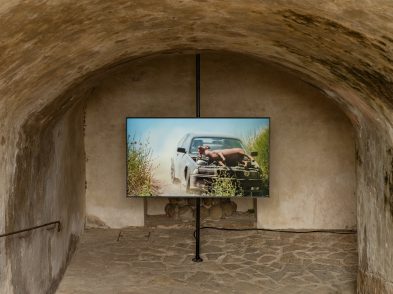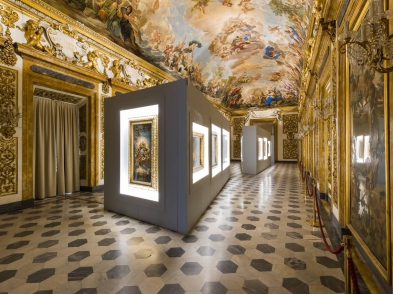Throughout the 1960s and 1970s, photographer Brian Duffy created the look of modern, creative Britain. With contemporaries David Bailey and Terence Donovan, Duffy (he was always known by his surname) enlivened the pages of the world’s leading style magazines with fashion shots and advertising images that were as restless, defiant and iconoclastic as he was.
The current Duffy exhibition at the Alinari National Museum of Photography will be, for many visitors, a revelation. Duffy’s work encapsulates an era. Yet at the height of his fame he turned away from the medium. Photography was becoming widely regarded as an art form-a transformation that Duffy helped bring about-when, in 1979, he took his last picture. His attempt to burn his archive of negatives was largely unsuccessful, but he did not return to the studio for 30 years, and then only for a BBC documentary. He died in 2010.
Vogue, Queen, Harper’s Bazaar and Nova were among the magazines that commissioned Duffy to bring his fresh approach to portraying top fashions. When Elle sent him to Florence in 1962, his style was already apparent. Using the street rather than the studio, Duffy placed his models in real situations but with an unexpected twist: an off-centre pose, perhaps, or a striking perspective that matched glamour with the informality of life.
Breaking with the familiar was a Duffy trademark. Whether his subject was a fashion model, actor or politician, he infused his images with personality. ‘You see something through a camera lens you don’t see with your eye,’ he once said, and it was not unusual for him to ask young models to sing, dance and skip.
Duffy had two outstanding advantages. One was studying fashion at art school in London. He understood how a garment worked and never obscured its line and look with irrelevant details. In his shoots, models appeared to own the outfits they were promoting.
The second advantage was his acute visual intelligence. As a difficult teenager in devastated post-war London, he had attended an experimental school that exposed students to art, opera and dance, and throughout his life he continued to paint. Crystal clear in his portraits is a hunter’s instinct for catching the moment and then pressing the shutter. ‘Photography is immediate,’ he believed, ‘because the next day you are wrapping fish and chips in it.’ Duffy’s prime inspiration was his own instinct, and although photography as art did not interest him, French photographers Lartigue and Cartier-Bresson were obvious influences.
Deference fell victim to the irreverence of the 1960s and, an anarchist at heart, Duffy liked to engage sitters in conversations, even arguments. As a result they look engaged, but not in the self-conscious task of being photographed. John Lennon, Jane Birkin (in one of the exhibition’s most memorable images), Michael Caine, Paul McCartney, Jean Shrimpton, Arnold Schwarzenegger and even notorious London mobsters the Kray twins look like they forgot about the camera.
The photographer was by now a star who could command big budgets. As the black-and-white imagery at which he excelled yielded to the taste for colour in the 1970s, Duffy gave new meaning to glamour. His work for Pirelli or Smirnoff, the vodka brand, emphasised the sensual potential of high-toned, well-printed colour, while his outstandingly successful campaign for Benson and Hedges, the British cigarette, brought out the humour in his vision.
Above all, the advertisements confirmed his position as a masterful image-maker. ‘Just workers,’ he modestly described his profession, ‘who want to be good at it.’ Decades before the modern tools of Photoshop became available, Duffy created optical illusions with lenses, lights and set building that made real photographs, with no manipulation involved, resemble trick photography.
‘It’s all done in the camera,’ he explained, about the instrument with which he was a virtuoso. His son Chris, who organised this finely chosen introduction to his father’s work, describes Duffy as ‘always innovating. He was very good technologically-he built his own 12-lens, 6×9 plate camera, and tried to create problems so that he could think of a way to solve them. The same thing every time was boring.’
This attitude fuelled his advances. David Bowie’s 1973 Aladdin Sane album cover, with its remarkable portrait and superbly airbrushed finish, drew together several technical skills into a popular icon of the decade.
But the dread of repetition may also have led to Duffy’s retreat from photography altogether. Working mostly by now in advertising, did the medium cease to interest him? Leaving at a high point, his reputation never suffered the decline brought by overexposure through a long career. Instead he took up antique furniture restoration and became, unsurprisingly, very good at it.
As this exhibition makes clear, Duffy’s work is receiving a new dimension of attention from curators and historians outside Britain. As Chris Duffy retrieves insights into his father’s achievements, the story is at last unfolding about the photographer whose black-and-white imagery captured the colour of the 1960s.
Duffy: The Photographic Genius
Until March 25, 2012
National Alinari Museum
Piazza S. Maria Novella 14a, Florence
www.alinarifondazione.it; tel. 055/216310






